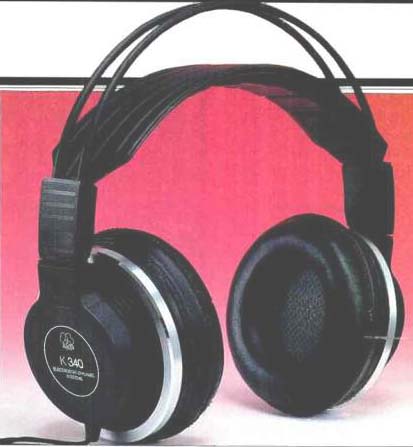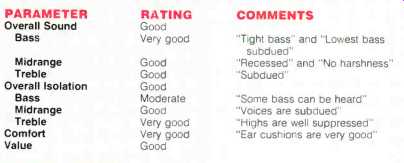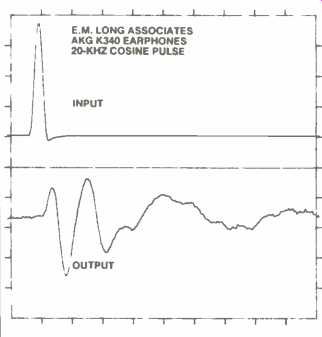
Transducer Design: Electrostatic tweeter, dynamic woofer.
Coupling to the Ear: Circumaural.
Equalization: Direct field.
Sensitivity: 117 dB SPL for 200 mW. Impedance: 400 ohms.
D.C. Resistance: Left, 318 ohms; right, 319 ohms.
Cord: Coiled, 7 3/4 feet long from left earcup, with 1/4-inch stereo phone plug.
Adjustment: Headband slides in de tented bails.
Weight: 14 oz. (0.387 kg).
Price: $249.
Company Address: 1525 Alvarado St., San Leandro, Cal. 94577.
The K340 earphones from AKG Acoustics are a tour de force of acoustical design. From the use of both electrostatic and dynamic transducers to the elaborate design of the acoustical earcup chambers, there is a level of engineering here that is seldom found in such a product. The K340 earphones are designed not only for smooth response but also for the exclusion of outside sounds. AKG makes both open and closed earphones; the open-air K280 earphones that I reported on in the January 1992 issue allowed outside sounds to be easily heard, while the closed design of the K340 blocks these sounds. Since the K340s do a reasonably good job of attenuating outside sounds, you can use them to monitor a recording in progress even when you are in the midst of the sounds being recorded.
Both the K340 and the K280 use two transducers in each earcup. In the K280, each transducer is a small dynamic unit. The K340 uses an electrostatic transducer for the treble and a dynamic unit for the bass; they are mounted on the same axis, with the electrostatic element in front of the dynamic transducer. Each earpiece contains separate sound chambers, with five acoustical resistances and five passive diaphragms mounted on a special baffle. There is also a tiny step-up transformer for the permanently charged electrostatic transducer. The AKG K340 earphones are definitely an elaborate design that takes many interrelated factors into account.
==========
Earphone Evaluation

GENERAL COMMENTS: Good fit to different heads; very comfortable; very low fatigue factor over long listening periods.
===========
The K340 headband is imitation leather. Foam-filled pockets on its underside rest against the top of the head, allowing air to flow between the headband and the wearer's head. The headband is attached to a sliding plastic piece on the bails; detents on the bails keep the headband in the selected position. You can adjust the ear cups easily without having to remove the earphones from your head. The left and right earcups are marked by an "L" and "R" embossed on the outside of the sliding bail adjustment, but it is hard to see these letters in low-light situations. The bails have a slight swiveling action that helps to make the earcups fit snugly against your head.
The foam-filled vinyl ear cushions are very comfortable. The tension that holds the earcups against the head is very moderate, and this, coupled with the comfortable ear cushions, makes long-term listening through these earphones possible. Overall, the comfort provided by the foam-filled headband, the light tension, and the vinyl-covered earcups make the K340 easy to live with even though it weighs a relatively heavy 14 ounces.
The bass output from the K340 is very good. This might be expected from a closed or sealed design, but air leaks can reduce the bass response of some earphones. While a major leak can cause a problem for the K340 earphones, they still produce good bass when a moderate leak occurs. This is a boon for those who wear glasses, which usually cause an imperfect seal between the earcups and the head.
The subjective sound qualities of the AKG K340 earphones were rated by members of a listening panel, all of whom are experienced in judging the sound produced by high-quality audio components. They were given a rating form and asked to listen to various types of program material and write down their comments.
My measurements showed that the bass output was very extended, with only a gradual roll-off of about 2 dB per octave from 600 Hz down to 80 Hz; from 80 Hz down to 40 Hz the roll-off was about 10 dB. This characteristic can be easily corrected by an ordinary bass tone control, but this much correction may not be needed, as some of the roll-off may have been caused by the lack of a completely tight seal around the ears of the B & K Head and Torso Simulator (HATS) manikin that I used for the measurements. In any case, if you don't have a tight seal or if you wear glasses, it is nice to know that you can obtain a very uniform output from the K340s with an ordinary bass control, found on most preamps, integrated amps, and receivers. Comments by listening panel members, such as "good bass," "tight bass," and "lowest bass notes slightly less than reference," indicate that they didn't feel a need for an increase in bass output. Comments about the sense of presence being "very dry," "subdued," and "less forward than reference" correlate well with the measurements that I made with the B & K HATS. (See "As Close As You Can Get," Audio, April 1991.)

Fig. 1--Output vs. time for 20-kHz cosine pulse.
The AKG K340 earphones showed a depression in the response from about 3 to 5 kHz when equalized with the diffuse-field correction curve of the B & K measuring system. The AKG literature indicates that the K340 earphones were designed with a direct sound-field equalization in mind, but I was not aware of this at the time of the measurements. The depression would have been even deeper had I used the direct-field equalization provided by the B & K system. The Stax SR-Lambda Pro Earspeakers, which I use as reference, also showed a broad dip around 2.8 kHz when measured with the B & K system's diffuse-field equalization (see Audio, April 1991), but it was less severe than the dip from the AKG K340; the listening panel all commented that the AKG K340s earphones sounded more subdued in the middle register than the reference earphones.
My own impression of the K340s is that they have a sound characteristic similar to many highly regarded and successful two-way bookshelf loudspeakers that are purposely designed with a depressed upper middle register. This type of response makes loudspeakers, or in this case earphones, very non fatiguing and easy to listen to over long periods, even with bright, forward, or harsh program material.
The AKG K340 earphones had difficulty reproducing the 500-Hz square wave that I use as one of my standard tests. The output waveform showed that the higher frequencies from the electrostatic transducer element arrived ahead of the lower frequencies from the dynamic transducer element.
To reproduce square waves accurately, the phase and amplitude of each harmonic must be exactly right; such was not the case with the K340 earphones. This result correlates well with the "subdued" sound of the K340s as compared to the sound of the reference earphones. The spectrum of the square wave also showed depressed upper midrange harmonics at 3.5 and 4.5 kHz, as expected.
Figure 1 shows the output of the AKG K340 earphones for a 20-kHz raised cosine pulse input. The input pulse is shown at the top and the output from the K340 below. I had a difficult time determining the absolute polarity of voice and music with the K340, and this certainly correlates well with the output shown here.
I also measured the output versus frequency response with a Fast Fourier Transform (FFT) analyzer, using the same 20-kHz cosine pulse; I placed a B & K 4133 condenser microphone directly in front of the coaxially mounted earphone elements. The response showed a rise at 2,400 Hz, a dip centered at 3,500 Hz, and good output up to 10 kHz, where it began to roll off.
The response showed no irregularities from reflections between the transducer diaphragm and the protective screen--or from the ear cushions, which are well padded. The relationship between the amplitude and phase of the output indicated some non-minimum-phase characteristics that are probably due to the offset between the two separate transducers. The AKG K340 earphones had almost no coloration when reproducing wide-band pink noise, which translates into low listener fatigue. The impedance, slightly more than 300 ohms, was lower than that of some earphones I have tested, but still high enough to ensure that the source's impedance had very little effect on frequency response.
The AKG K340 earphones are very comfortable, and they make even less than deal program material, with slight distortion and noise, quite listenable.
The listening panel members rated the K340 earphones as "good" for overall sound quality and "very good" for comfort. I think these earphones are very suitable for extended listening to a wide variety of program material. With this in mind, I think that they are a very good value and suggest that you give them serious consideration.
-Edward M. Long
(Source: Audio magazine, Nov. 1992)
Also see:
AKG K280 Earphones (Jan. 1992)
Koss ESP/950 Earphones (Auricle; Nov. 1992)
Grado Labs SR200 & Joseph Grado Signature HP-2 Earphones and HP-1 ADC Earphone Amp (Nov. 1992)
= = = =